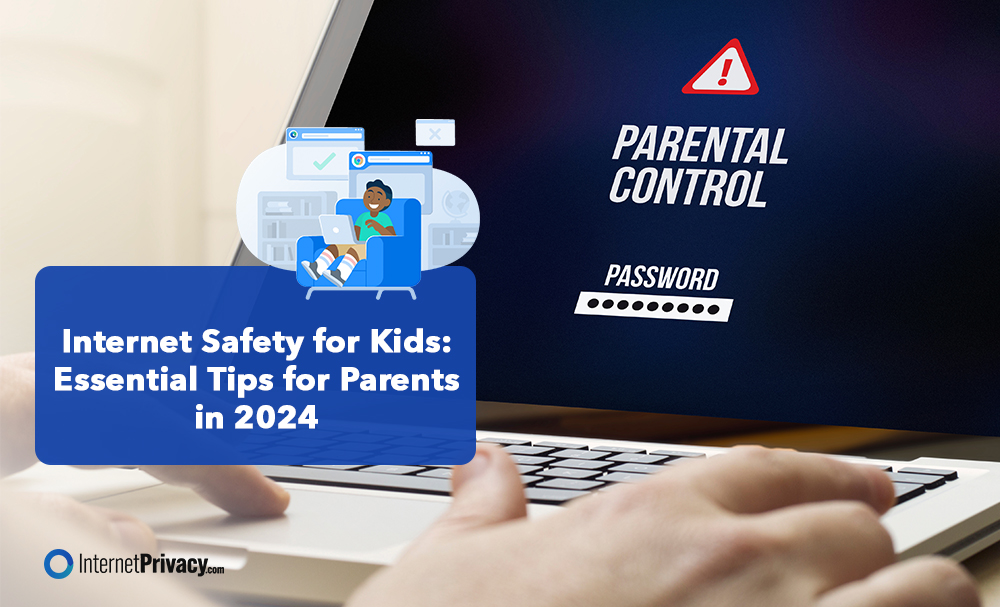Internet Safety for Kids: Essential Tips for Parents in 2024

Teaching young kids about internet safety is paramount. Parents are crucial in preparing their children to navigate the online realm securely. This involves establishing guidelines, educating them about cyberbullying and online threats, and setting boundaries. We’ll delve into the significance of internet safety, offer key advice for parents, address common child concerns about online spaces, discuss effective communication strategies, and provide resources for further education. Let’s make safeguarding our children’s online experiences a priority in 2024.
The Importance of Teaching Kids about Internet Safety
Parents and educators play pivotal roles in shielding children from online dangers like cyberbullying and predators. Educating kids about potential risks empowers them to navigate the digital landscape responsibly. Monitoring kids’ safe online activities and implementing parental controls are essential to creating a secure kids, safe online environment. Together, parents, educators, and trusted adults can safeguard children from various online threats.
Why is it Important for Parents to be Involved?
Parents’ active involvement in their children’s online activities is vital for ensuring their safety in the digital realm. Implementing parental controls and providing practical advice on internet safety are effective measures to protect children’s personal information and promote responsible digital citizenship. Clear boundaries, such as setting screen time limits, help prevent excessive internet use and exposure. Monitoring social media interactions lets parents intervene if worrisome behavior or content arises.
Educating children about online privacy, including avoiding sharing personal information and interacting with strangers, is crucial for fostering a safe online environment. Maintaining open communication channels where kids can freely discuss their online experiences and concerns builds trust and facilitates ongoing monitoring.
What are the Dangers of the Internet for Kids?
The internet presents various risks to kids, including online bullying, exposure to inappropriate content playing online games, and privacy threats like identity theft. Children must grasp practical measures for safeguarding their user accounts and personal information online. Online bullying can profoundly affect a child’s mental well-being and self-esteem, while exposure to inappropriate content in online games can cause confusion and distress. Identity theft risks can lead to financial loss and lasting repercussions. Parents and guardians should educate kids about creating strong passwords, refrain from sharing personal information, and exercise caution when interacting with strangers online to counter these dangers.
Top Internet Safety Tips for Parents
Parents can secure their children’s online safety by employing key internet safety measures. This includes utilizing parental control software, overseeing online interactions, and establishing guidelines for chat room usage. It is essential to teach kids to protect their personal information and refrain from sharing sensitive details like their address, phone number, or school name.
It is crucial to encourage open dialogue where children can freely discuss their online encounters with parents or trusted adults. Educating children about the risks of engaging with strangers online and emphasizing the importance of never arranging to meet someone they’ve only encountered virtually are vital steps.
1. Set Rules and Boundaries
Setting rules and boundaries for children’s internet usage ensures online safety. Parents can collaborate with law enforcement, utilize educational resources, and teach kids to avoid sharing personal information on public Wi-Fi networks. Establishing clear guidelines provides a framework for safe online behavior. Law enforcement is key in investigating cybercrime and offering resources to address online risks. Educational materials, like lesson plans focused on internet safety, empower parents and children with knowledge to navigate the digital world securely. Teaching about the dangers of sharing personal information on mobile phones and public Wi-Fi networks can significantly mitigate the risk of cyber threats.
2. Educate Your Child about Online Privacy
Educating children about online privacy is vital to protect their personal information. Teaching them to keep details private, set sharing rules, and recognize risks like phishing scams on most social media platforms is crucial for online safety. Kids must grasp the importance of not sharing personal info like full name, address, or phone number online. Encouraging safe internet habits early helps them navigate responsibly.
Parents and educators guide children in the digital age by developing a healthy tech relationship, emphasizing privacy and safety. Open communication and clear boundaries empower kids to safeguard themselves online for a positive digital experience.
3. Monitor Your Child’s Online Activity
Monitoring your child’s online activity is a proactive approach to ensuring internet safety. Parents can use parental controls, set screen time limits, and promote smart decision-making online. Parental controls filter content, limit website access, and track activities for red flags. Open communication about privacy and online etiquette is crucial. Encouraging critical thinking and questioning online information fosters a healthy skepticism. Managing screen time involves setting clear usage guidelines and balancing with other activities. Establishing device-free zones like bedrooms aids in reducing screen exposure.
Teaching kids about online risks like sharing personal information and cyberbullying is essential. Encouraging reporting of suspicious behavior promotes control over online safety. Positive interactions and kindness promote a safer and more enjoyable digital experience for many kids.
4. Use Parental Control Software
Parental control software is crucial for managing online risks and creating a safe digital environment for children. It enables parents to set up user accounts, apply age restrictions, and monitor mobile device social networking sites and media usage. Filtering inappropriate content and websites ensures kids are not exposed to harmful material online. Tailoring restrictions for each child’s user account allows parents to control content access, promoting a secure online experience. Monitoring social media activities helps parents track interactions, identify signs of cyberbullying or predatory behavior, and intervene promptly.
This proactive approach fosters open communication and trust in the online world, keeping parents engaged in their children’s online lives.
5. Teach Your Child about Cyberbullying
Educating children about cyberbullying is vital for helping them recognize and respond to online harassment effectively. Parents can achieve this by discussing the impacts of online bullying, identifying harmful content in chat rooms, and initiating open conversations. Teaching kids about online safety measures, such as setting privacy settings and avoiding sharing personal information, is crucial. Empowering children with these skills protects them from cyberbullying and enhances their digital literacy and awareness.
Parents should encourage their children to speak up if they experience being bullied online by cyberbullying, reassuring them that help and support are available.
6. Encourage Open Communication
Promoting open communication with children is crucial for fostering a safe online environment. Encouraging kids to share their experiences, providing useful tools and safety tips, and partnering with law enforcement officials are essential strategies for cultivating digital citizenship and online safety. Establishing trust and support enables children to navigate the virtual world responsibly, while active parental participation helps monitor potential dangers.
Regular discussions about internet etiquette, privacy, and recognizing online risks instill accountability and digital awareness. Setting limits on screen time and promoting healthy online habits encourage a balanced approach to technology. Collaboration with educational institutions and community organizations enhances efforts to educate children about internet safety contract cybersecurity. Facilitating conversations with law enforcement about reporting suspicious activities equips children with skills to protect themselves online.
Common Internet Safety Concerns for Kids
Children commonly face internet safety concerns such as online predators, exposure to inappropriate content, and risks of identity theft. Parents must address these issues proactively to safeguard their children in the digital realm. Online predators exploit children through various platforms, making it crucial for parents to educate their kids about recognizing warning signs and maintaining open communication. The widespread availability of inappropriate content online necessitates implementing parental controls, setting strict rules, and monitoring screen time to protect children from encountering harmful material.
Identity theft is a significant risk, with young individuals often unknowingly sharing personal information. Encouraging safe online behavior, emphasizing privacy, and teaching responsible sharing are essential steps parents can take to mitigate this risk and keep children safe online.
1. Cyberbullying
Cyberbullying poses a significant threat to children’s online safety, causing emotional distress and potential harm. Parents can support their children in combating cyberbullying by using educational lesson plans, addressing instances of online bullying, recognizing privacy risks, and offering practical advice. The impact of cyberbullying on children’s mental and emotional well-being can lead to issues like anxiety, depression, and low self-esteem. Parents must educate themselves and their children on identifying harmful content and behavior and keeping children safe online. Fostering open communication and providing a safe discussion space empower children to navigate the digital world safely.
2. Online Predators
The presence of online predators presents a significant threat to children’s safety, necessitating parents’ proactive efforts to educate and shield them from potential dangers in the online realm. Parents can mitigate the risk of children falling victim to online predators by teaching safety tips, establishing boundaries for online interactions, and initiating conversations. Parents need to set clear rules regarding sharing personal information and whom children can interact with online while monitoring their online activities to ensure adherence to proper internet behavior. Emphasizing the importance of privacy and discouraging children from sharing personal details with strangers or engaging in online games are crucial aspects of parental guidance.
Encouraging communication through moderated platforms and advocating for reporting suspicious behavior further enhances children’s safety by minimizing the chances of interacting with individuals with malicious intentions.
3. Exposure to Inappropriate Content
Children may encounter inappropriate online content, including harmful websites and materials that jeopardize their safety. Parents can mitigate this risk by utilizing lesson plans, discussing the safe usage of social media platforms, and educating kids on identifying and avoiding inappropriate content online. Instilling digital literacy and critical thinking skills is crucial for children to navigate the internet responsibly and differentiate between safe and dangerous online platforms. Open communication about online activities fosters a secure environment for children to share concerns or encounters with inappropriate content, strengthening the parent-child relationship and addressing issues promptly. Parents can enhance their understanding of online safety through informative websites, educational videos, and workshops.
This creates a secure online environment that promotes healthy digital habits and protects children from potentially harmful content.
4. Identity Theft
Identity theft poses a significant risk for children online, underlining the importance of safeguarding personal information and recognizing phishing scams. Parents can mitigate this risk by teaching practical tips like protecting user accounts, sharing information cautiously, and identifying potential threats. Emphasizing the creation of strong, unique passwords using a combination of letters, numbers, and special characters enhances account security. Guiding children to be selective about online information and avoiding sharing sensitive details with strangers or publicly is crucial.
Discussing the risks of clicking on unfamiliar links to inappropriate websites or downloading attachments from unknown sources helps children prevent phishing scams, emphasizing the importance of verifying website and email legitimacy before sharing personal information.
How to Talk to Your Child about Internet Safety?
Initiating conversations with your child about internet safety is essential for building a culture of open online communication and trust. Parents can use conversation starters, discuss the importance of protecting personal details, address social media interactions, and highlight the risks of cyberstalking to equip their children with digital citizenship skills. Introducing the topic through age-appropriate discussions using real-life examples or scenarios is effective. Encouraging children to ask questions and express concerns creates a safe space for dialogue. Emphasizing ‘think before you click’ helps children grasp the permanence of online actions and the impact of sharing sensitive personal information privately. Open dialogue fosters understanding and empowers children to make informed decisions online.
Resources for Parents to Learn More about Internet Safety
Parents have access to various resources to bolster their understanding of internet safety and effectively safeguard their children online. They can utilize parental controls and educational lesson plans to encounter online and learn safety tips to prevent identity theft. Collaborating with educators is key to creating a safe online environment. Net Nanny and Qustodio are recommended parental control tools for monitoring and setting restrictions on children’s online activities.
Websites like Common Sense Media and National Online Safety offer valuable educational resources on digital citizenship and online safety. Parents should also educate themselves on identity theft prevention strategies, such as safeguarding personal information and recognizing phishing scams. Collaboration with teachers and school administrators can provide further insights into best practices for online safety education in academic settings.





